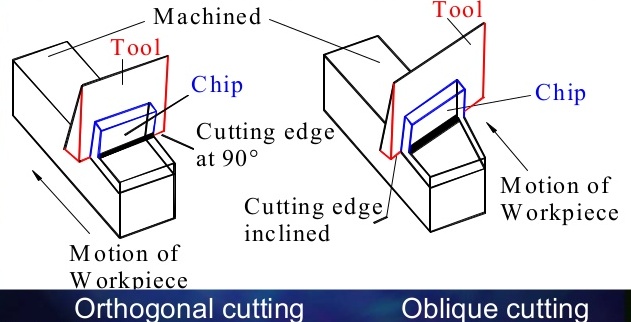Following are the two methods of metal cutting depending upon the arrangement of cutting edge with respect to the direction of tool travel:
1. Orthogonal cutting or two dimensional cutting.
In orthogonal cutting, the cutting edge of the tool is perpendicular to the direction of tool travel. The cutting edge clears the width of the workpiece on either ends. The chip flows over the tool face and the direction of the chip flow velocity is normal to the cutting edge. The maximum chip thickness occurs at the middle. In orthogonal cutting, the shear angle is the angle between the rake face and the shear plane.
2. Oblique cutting or three dimensional cutting.
In oblique cutting, the cutting edge of the tool is inclined at an angle less than 90° to the direction of tool travel. Frequently, more than one cutting edges are in action. The cutting edge may not clear the width of the work piece. The chip flows
on the tool face at an angle less than 90° with the normal on the cutting edge. The maximum chip thickness may not occur at the middle.
11) In oblique cutting system, the cutting edge of the tool
may not clear the width of the work piece

Related Production Engineering MCQ with Answers
all of the above
Following are the two methods of metal cutting depending upon the arrangement of cutting edge with respect to the direction of tool travel:
1. Orthogonal cutting or two dimensional cutting.
In orthogonal cutting, the cutting edge of the tool is perpendicular to the direction of tool travel. The cutting edge clears the width of the workpiece on either ends. The chip flows over the tool face and the direction of the chip flow velocity is normal to the cutting edge. The maximum chip thickness occurs at the middle. In orthogonal cutting, the shear angle is the angle between the rake face and the shear plane.
2. Oblique cutting or three dimensional cutting.
In oblique cutting, the cutting edge of the tool is inclined at an angle less than 90° to the direction of tool travel. Frequently, more than one cutting edges are in action. The cutting edge may not clear the width of the work piece. The chip flows
on the tool face at an angle less than 90° with the normal on the cutting edge. The maximum chip 15 thickness may not occur at the middle.

all of these
all of these
The addition of lead, sulphur and phosphorus to low carbon steels, help to
* reduce built up edge
* break up chips
* improve machinability